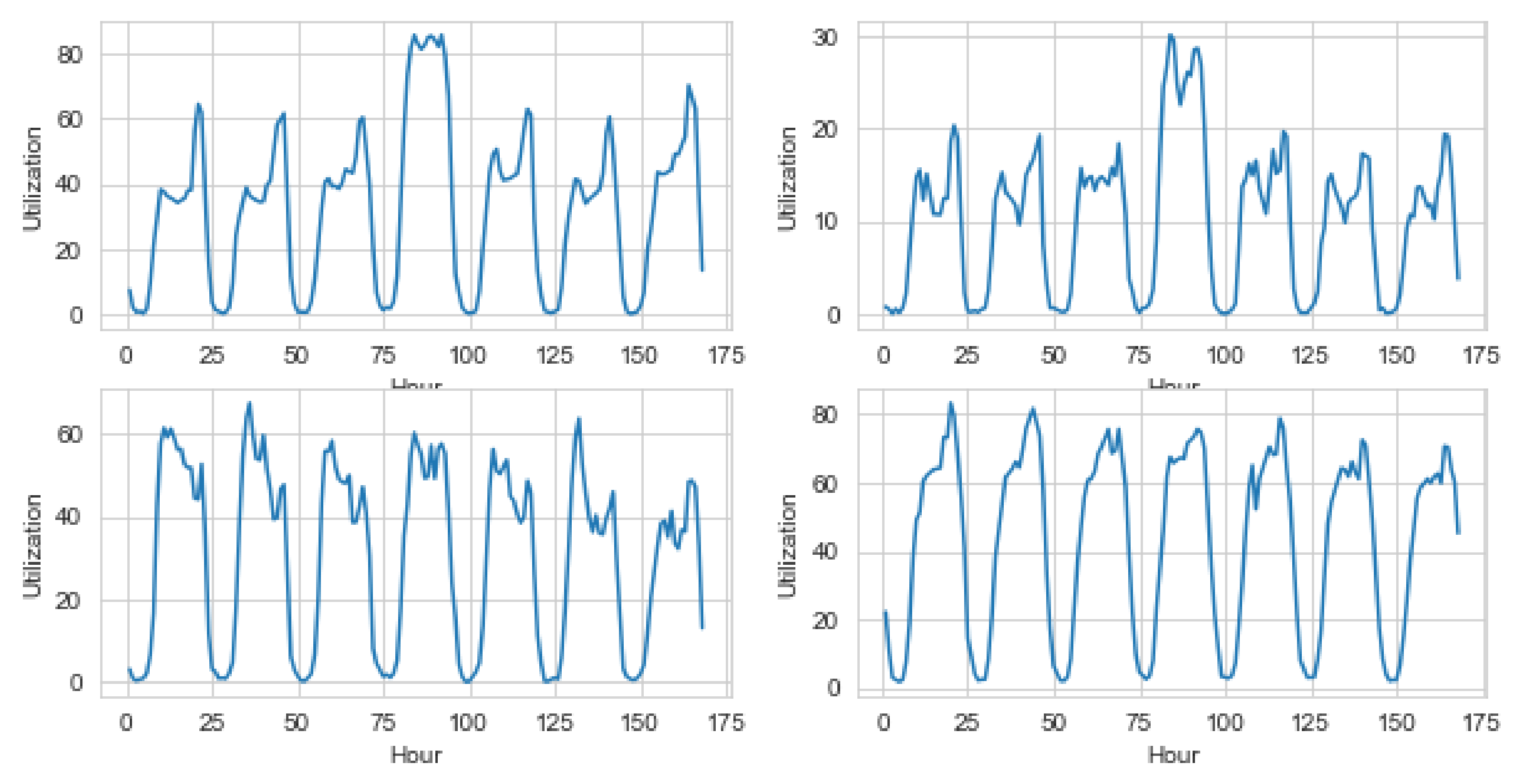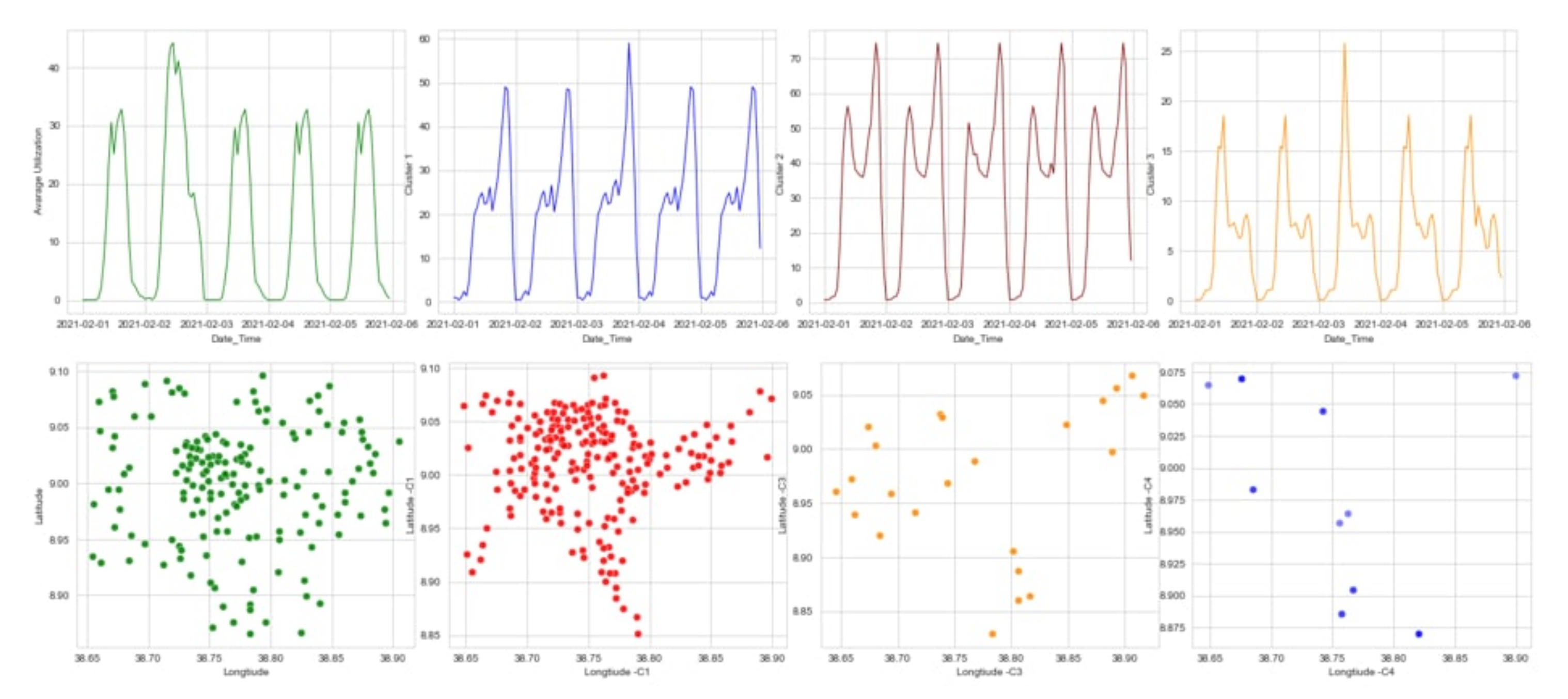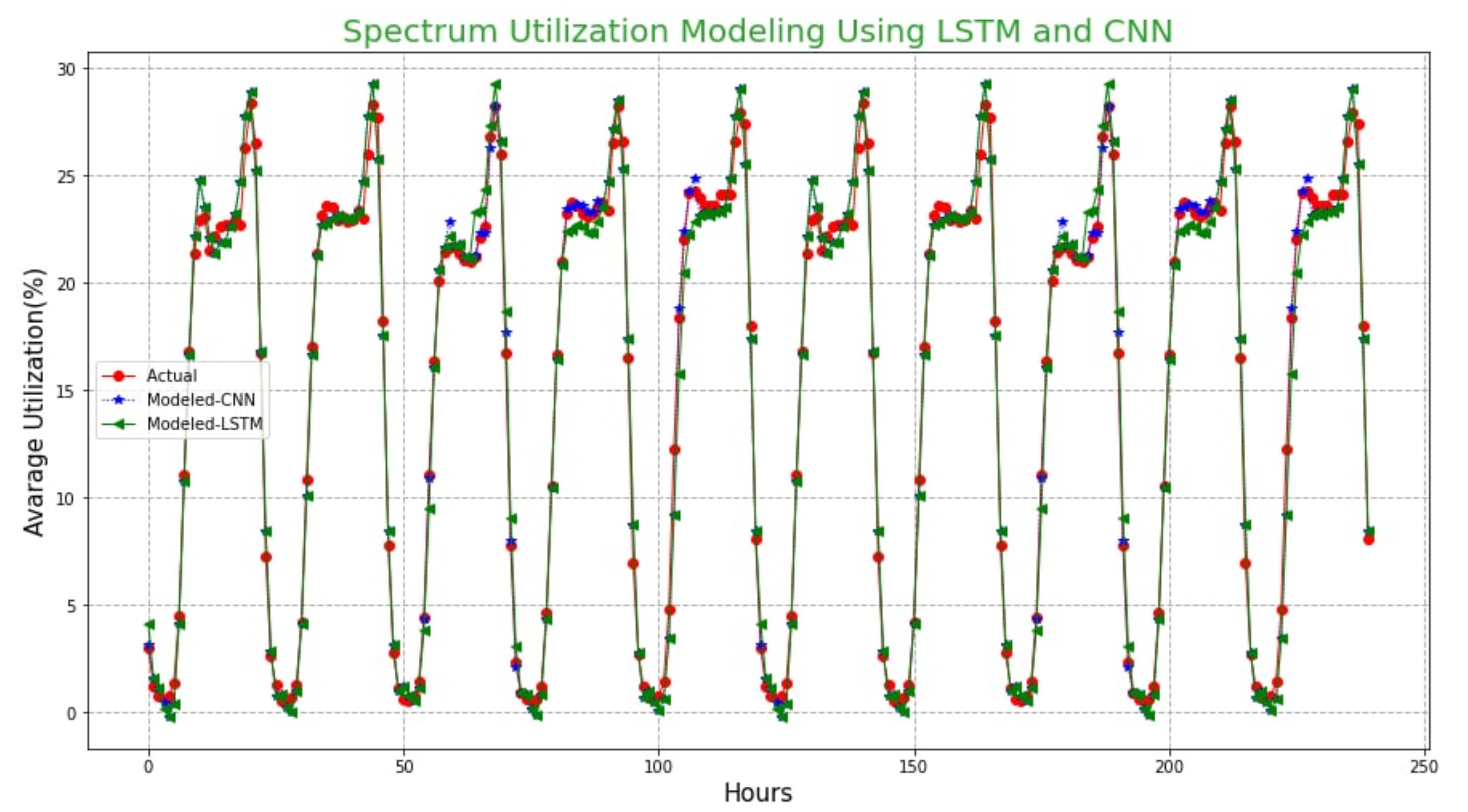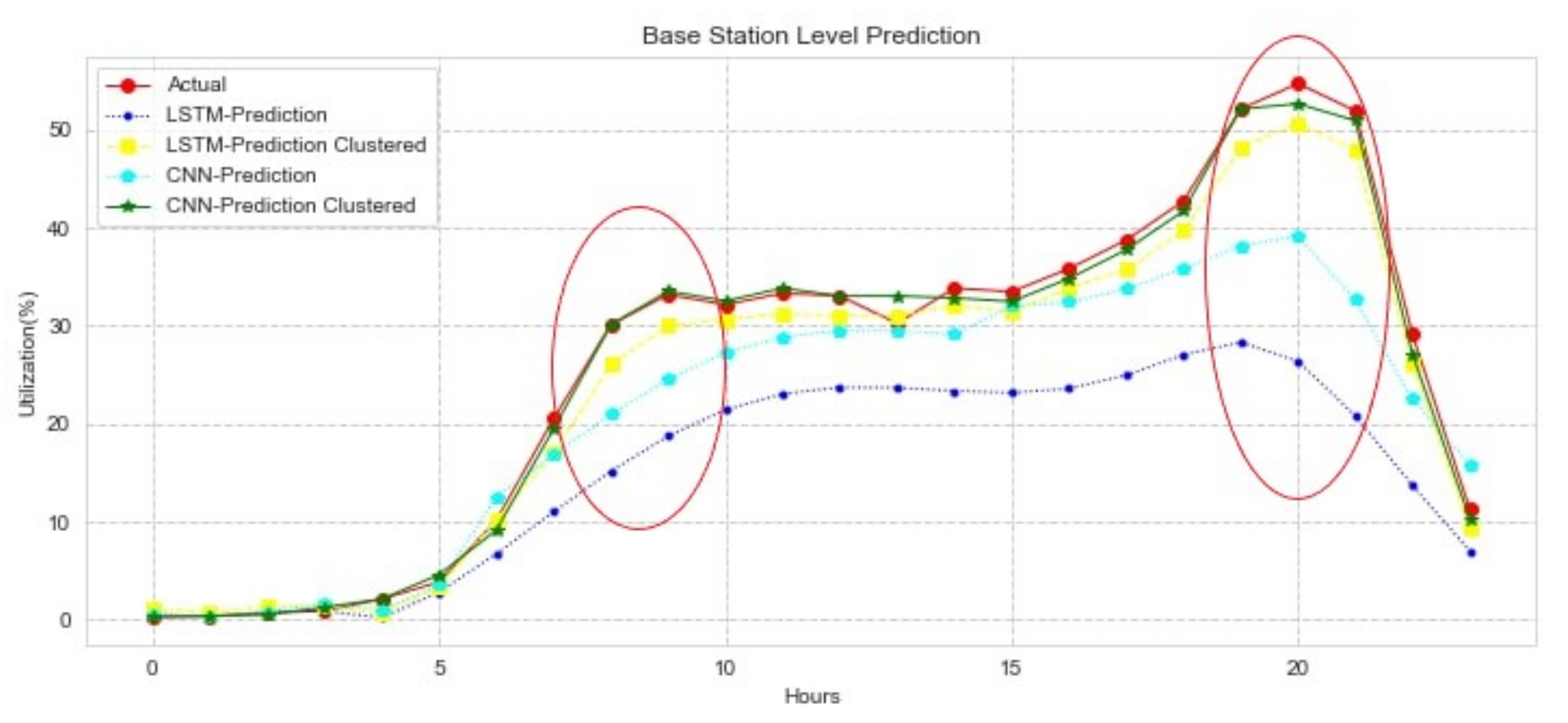K-Means Clustering Assisted Spectrum Utilization Prediction with Deep Learning Models †
Abstract
1. Introduction
- Map channel utilization measurements into spectrum utilization using an industry practiced utilization formula. Erlang B is used to validate the formula and the mapping in both cases is found to be similar;
- RNN (specifically, Long Short Term Memory (LSTM)) and Convolutional Neural Network (CNN) are applied to predict future utilization on a per cluster level;
2. Spectrum Utilization Analysis
2.1. Spectrum Bands in Cellular Mobile Networks
2.2. Traffic Engineering
3. Methodology
3.1. Utilization Clustering with K-Means
3.2. Spectrum Utilization Prediction Approach with Deep Learning
3.2.1. Spectrum Utilization Modeling Using CNN
3.2.2. Spectrum Utilization Modeling Using LSTM
4. Results and Discussion
4.1. Experimental Settings
4.1.1. Data Preprocessing
4.1.2. Hyperparameter Tuning
4.1.3. Evaluation Metrics
4.2. Model Performances
4.2.1. Clustering with K-Means
4.2.2. Prediction Performance
5. Conclusions
Author Contributions
Funding
Data Availability Statement
Conflicts of Interest
References
- ITU-R. Spectrum Occupancy Measurements and Evaluation; Report SM.2256-1; ITU: Geneva, Switzerland, 2016. [Google Scholar]
- Dalela, P.K.; Nayak, A.; Tyagi, V.; Sridhara, K. Analysis of spectrum utilization for existing cellular technologies in context to cognitive radio. In Proceedings of the 2011 2nd International Conference on Computer and Communication Technology (ICCCT-2011), Allahabad, India, 15–17 September 2011; pp. 585–588. [Google Scholar]
- Barnes, S.D.; Jansen Van Vuuren, P.A.; Maharaj, B.T. Spectrum occupancy Investigation: Measurements in South Africa. J. Int. Meas. Confed. 2013, 46, 3098–3112. [Google Scholar] [CrossRef][Green Version]
- Agarwal, A.; Sengar, S.; Gangopadhyay, R. Spectrum Occupancy Prediction for Realistic Traffic Scenarios: Time Series versus Learning-Based Models. J. Commun. Inf. Netw. 2018, 3, 44–51. [Google Scholar] [CrossRef]
- Luis, P.; César, H.; Enrique, R.-C. Modeling of GSM Spectrum Based on Seasonal ARIMA model. In Proceedings of the 6th IEEE Latin-American Conference on Communications, Cartagena, Colombia, 5–7 November 2014. [Google Scholar]
- Jordan, J. Hyperparameter Tuning for Machine Learning Models. 2017. Available online: https://www.jeremyjordan.me/hyperparameter-tuning/ (accessed on 23 January 2021).
- Saitwal, M.S. Dynamic Spectrum Sharing between Mobile Network Operators in GSM. Ph.D. Thesis, Indian Institute of Technology Hyderabad, Telangana, India, 2015. [Google Scholar]
- Musey, J.A.; Barlow Keener, E. The Spectrum Handbook; Summit Ridge Group, LLC: New York, NY, USA, 2018. [Google Scholar]
- Bantigegn, F. Hybrid Clustering and Deep Learning-Based Spatio-Temporal Analysis of Spectrum Usage. Master’s Thesis, Addis Ababa University, Addis Ababa, Ethiopia, 2021. [Google Scholar]
- Marsa-Maestre, I.; Ito, T.; Pollin, S.; Chiumento, A.; Gimenez-Guzman, J.M. Efficient spectrum usage for wireless communication. Wirel. Commun. Mob. Comput. 2019, 8719849. [Google Scholar] [CrossRef]
- Maya, M. Convolutional neural networks for forex time series forecasting. In AIP Conference Proceedings; AIP Publishing LLC: Melville, NY, USA, 2021; Volume 2459, p. 030024. [Google Scholar]
- Staudemeyer, R.C.; Morris, E.R. Understanding LSTM: A tutorial into Long Short-Term Memory Recurrent Neural Networks. arXiv 2019, arXiv:1909.09586. [Google Scholar]





| Network Type | Channel Type | Frequency Number |
|---|---|---|
| GSM 900 | BCCH | 14 |
| TCH | 47 | |
| Guard band | 1 | |
| GSM 1800 | BCCH | 24 |
| TCH | 61 | |
| Guard band | 1 |
| Hyperparameters | Value | |
|---|---|---|
| CNN | LSTM | |
| Hidden Layer | 2 | 3 |
| Number of Filters | (64), (32) | - |
| Kernel Size | (3), (3) | - |
| Hidden layer Neurons | - | (48), (32), (32) |
| Batch Size | 64 | 128 |
| Dropout | 0.2% | 0.2% |
| Maxpooling-1D | 2 | - |
| Dense layer | (50),(24) | - |
| Optimizer | Adam | Adam |
| Activation Function | ReLU | ReLU |
| Epoch | 2000 | 100 |
| Clustered | Non-Clustered | |||
|---|---|---|---|---|
| RMSE | MAE | RMSE | MAE | |
| LSTM | 0.8 | 0.845 | 1.197 | 1.057 |
| CNN | 0.585 | 0.26 | 0.767 | 0.521 |
| RMSE | MAE | MAPE | MSE | |
|---|---|---|---|---|
| LSTM-Prediction | 13.34 | 010.325 | 7.684 | 1.434 |
| LSTM-Prediction Clustered | 2.4492 | 2.092 | 6.872 | 0.641 |
| CNN-Prediction | 7.114 | 5.058 | 4.433 | 0.589 |
| CNN-Prediction Clustered | 1.04 | 0.76 | 2.3821 | 0.201 |
Publisher’s Note: MDPI stays neutral with regard to jurisdictional claims in published maps and institutional affiliations. |
© 2022 by the authors. Licensee MDPI, Basel, Switzerland. This article is an open access article distributed under the terms and conditions of the Creative Commons Attribution (CC BY) license (https://creativecommons.org/licenses/by/4.0/).
Share and Cite
Shawel, B.S.; Bantigegn, F.; Debella, T.T.; Pollin, S.; Woldegebreal, D.H. K-Means Clustering Assisted Spectrum Utilization Prediction with Deep Learning Models. Eng. Proc. 2022, 18, 2. https://doi.org/10.3390/engproc2022018002
Shawel BS, Bantigegn F, Debella TT, Pollin S, Woldegebreal DH. K-Means Clustering Assisted Spectrum Utilization Prediction with Deep Learning Models. Engineering Proceedings. 2022; 18(1):2. https://doi.org/10.3390/engproc2022018002
Chicago/Turabian StyleShawel, Bethelhem S., Frehiwot Bantigegn, Tsegamlak T. Debella, Sofie Pollin, and Dereje H. Woldegebreal. 2022. "K-Means Clustering Assisted Spectrum Utilization Prediction with Deep Learning Models" Engineering Proceedings 18, no. 1: 2. https://doi.org/10.3390/engproc2022018002
APA StyleShawel, B. S., Bantigegn, F., Debella, T. T., Pollin, S., & Woldegebreal, D. H. (2022). K-Means Clustering Assisted Spectrum Utilization Prediction with Deep Learning Models. Engineering Proceedings, 18(1), 2. https://doi.org/10.3390/engproc2022018002






